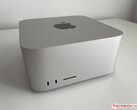Apple offers a total of five processor versions for the MacBook Pro 14. In addition to the M1 Pro (with 8 or 10 CPU cores and 14 or 16 GPU cores), the manufacturer also offers the faster M1 Max chips, which offer much more GPU performance with 24 or 32 cores. We reviewed the entry-level model of the MacBook Pro 14 late last year, and now we had the chance to take a closer look at a more expensive SKU with the M1 Max SoC and 24 GPU cores. You are also forced to select at least 32 GB RAM for the M1 Max, so the price is about 1000 Euros higher compared to the base model.
Our initial test results were promising. The CPU performance is very good and on par with other MacBook Pro models we tested with the 10-core CPU. The efficiency is particularly convincing, because Apple's CPU at 30W can keep up with the lates chips from AMD and Intel, which consume much more power. The 24-core GPU consumes around 35W and does not need as much power as the 32-core model, but is also 20% slower on average. Still, the performance is much better compared to other 35W GPUs (Nvidia GeForce RTX 3050 or 3050 Ti, for example) and is pretty close to a fast version of the RTX 3060 in native benchmarks instead.
We start to see a noticeable difference between the MacBook Pro models in combined CPU/GPU workloads. While the larger MBP 16 can utilize the full performance, the M1 Max in the smaller MBP 14 is clearly limited. We see a package power of 54W at the start of the test, but it quickly drops to around 42W after a couple of seconds, which is comparable to the base model. The fans have plenty of headroom, but the 96W power adapter seems to be a limiting factor. If we look at the data of the MBP 16, we expect a maximum consumption of around 120W, but the power adapter just cannot deliver this power. The performance might be better with the 140W PSU from the MBP 16, but the availability of the PSUs is very limited right now and we could not test it with our review unit.
Apple offers its two current MacBook Pro models with the M1 Pro and M1 Max SoCs and suggests the same level of performance for the smaller MacBook Pro 14, but this is not the case. The 14-inch model is significantly slower when you stress both the CPU and the GPU at the same time, which is also a result of the power adapter. You pay the full price for the M1 Max in the MBP 14, but you only get the full performance in the larger 16-inch MacBook Pro.
We recommend the MacBook Pro 14 with the M1 Pro and the upgrade to the 10-core CPU would be a better investment, because it is much more important when you use apps like Adobe Photoshop or Premiere Pro, for example. If you really need the additional GPU performance of the M1 Max or 64 GB RAM, we recommend you get the larger MacBook Pro 16. Please see our comprehensive reviews of the current MacBook Pro models for more information including extensive benchmarks and measurement results:




















